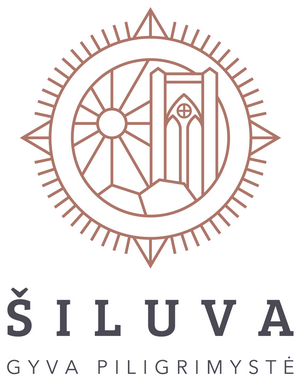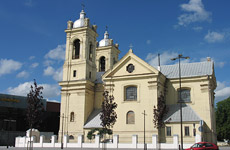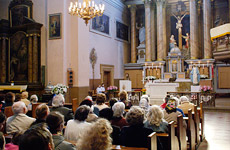Church service time
Sunday
08.30 a.m. St. Mass (Polish language)
10.00 a.m. St. Mass
11.30 a.m. St. Mass
01.00 p.m. St. Mass (Spanish language)
03.00 p.m. St. Mass (Latin language)
06.00 p.m. St. Mass
Weekdays:
06.00 p.m. St. Mass
Friday:
05.30 p.m. Adoration of St. Sacrament
Saturday
10.00 a.m. morning Mass
06.00 p.m. evening Mass
Contacts:
Gedimino street 1, Kaunas, LT-44332 Lithuania
Office telephone: +370 37 201340
Parson: +370 677 30997
Secretary: +370 678 39858
Email: karmelitubaznycia@gmail.com
History
If gazing to the Grenhill slopes from the Nemunas, you will notice the white towers of the St. Cross church first of all. The place it is situated now was once a distant locality called Kaunakiemis. In 1510 Darata Nabiene gave a plot of land as a present to build a temple by the river Nemunas. This first small St. Cross stone church was used as a chapel for a long time and it was managed by the deans of Kaunas parochial church (now Arch cathedral basilica in Kaunas).
It was not until the 17-th century that the parish was established at it. On the 23-rd of July, 1685 under the care of the dean Kazimieras Žodkevičius the fundamental stone foe building a new brick church was sanctified and on the 27-th June, 1700 the new St. Cross church was already built and sanctified by Vilnius bishop Konstantinas Kazimieras Bzostauskas. The building has traditional east – west orientation.
The temple is a wonderful monument of late baroque. The architect and the constructo of Pažaislis convent Pietro Putinis is believed to have designed it as the DominicanChurch of St. Sacrament. It is a two – tower building of Latin cross shape. The church facades are of vertical proportions. There are triangle pediments in all four facades; oval windows with notches like in the façade of Pažaislis church are seen here too. The western main facade triangle pediment which fills the space between two three – step towers is crowned with the small chapel form tower. The middle spaces of two towers are decorated with statues of saints. The tops of towers are finished with dome shaped helmets with crosses and small corner towers. The towers and pediments might have suffered during the Norh War (1700 – 1721) and were not finished for a long time being covered with boards. Finally, the pediments were installed only in 1830, while the towers were constructed around (1895 – 1900). There are closed low chapels (built at the church in 1773) and two vestries on both sides. Two closed domes give the impression of a changing internal space.
The comprehensive description of the 1716 church interior recreates the former picture: two- storied main sanctuary with a canopy was decorated with white Corintian pillars and statues of saints between them. Magnificent cross with the great sculpture of the Crucifix was in the centre of the sanctuary. The other four sanctuaries were associated with Jesus Christ’s torment too. There were lots of frescos in the arches. Some of them have already decayed and were later restored with pictures painted by J. Jankevičius in 1939.
In the second half of the 18-th century the St. Cross shurch is already linked with the monastery of Carmelites. Its history is as follows: The barefooted monks of the Order of Carmelites bought a brick house with a garden in Kaunas near the Nemunas in1706 summer. Then they bought another house and several plots of land. Soon they built there the Chapel of Terese Aviliete, and in 1726 they built the church of St. Elijus. But only in 1770 the barefooterd Carmelits, having received the permissions of Vilnius authorities and bishop as well as having reached an agreement with Kaunas administration to exchange their property for the St. Cross church and having paid for it 40000 gold currency, (from 1772) got it. Their spiritual life was based on prayers to Mary and Christ’s suffering. Their chief was father Kristupas. The monks built two – storied brick house near the church, renovated the church, arranged St. Mary, St. Teresa Aviliete and Cross John sanctuaries.
In 1831, when Lithuania was under the power of Russia and after the spread of cholera epidemic, there was established the hospital on the first floor of the monastery with arched cells, a dining room, a kitchen and a store room, while 19 cells and a library was arranged on the second floor. 5 years later, when epidemic replaced, the monastery was turned into hospital again. In 1845 the Russian czarist government closed the church and the monastery and used it as a store – house for carts, harness and other things. Six baroque sanctuaries, statues and pictures were destroyed or lost. When in 1880 the decision was made to turn the church into a military store house, the organ and the pulpit were destroyed, the window spaces were walled up, the new door was cut out.
However, in 1881 after the appeal of bishop Aleksandras Kazimieras Beresnevičius and people, the St. Cross church was returned to the believers. It became the town parochial church again. 5 new sanctuaries were built, the pulpit, the organ and 3 new bells were installed in 1885 – 1898. The interior was painted by Bachaufas. John Kerle from Tirol decorated the vaults with new pictorial art. Later the church interior and exterior were renovated in 1925 – 1934.
Now we can see the same sanctuaries, pulpit and organ. The monumental main sanctuary fills the entire width and height of the presbytery, its high and slender columns seem to set in a frame the Crucifix.
The God Mother and St. Joseph sanctuaries are in the wings of transept (both pictures painted by Mykolas Elvyras Andrioli). The other two – those of Carmelite God Mother’s and St. Mary picture in Rome.
The other particular characteristic of the church is its iconographical program in 18 figure compositions painted in the vaults. They make the continuous cycle of Jesus Christ mystery. These wall pictures belong to the academism of the 19-th century.
Yet the panoramic composition in the dome “Taking of Elijus into the heaven in the fire cart”| is characteristic of baroque apotheosized paintings. It is dedicated to the founder of the Carmelite order, prophet Elijus who didn’t die, but was taken to heaven in the fire cart by the gust of wind. (2 King 1, 8). It is a rare plot in Lithuanian religious painting.
In 1956 Liudas Truikys painted two compositions on the theme of Jesus Christ suffering on the exterior of the St. Cross church: “The Crucifying of Jesus”| is in the bay of eastern frontage, while “St. Mary and St. John” – in the southern bay. Both pictures blend organically into the entire iconography symbolizing God’s sacrifice of love.
The works of the 19 th century make the greatest part of sacral paintings. The black painted cupboard containing the relief portrait of canon Butkevičius, the middle font and the dish for sacred water as well as various handicraft should be mentioned.
Now this spacious and cosy St. Cross church is living with its daily achievements, joys and problems. Saving and protecting this valueable architectural and art legacy is the greatest task of the church, its community and the citizens of Lithuania.









